George Mason University
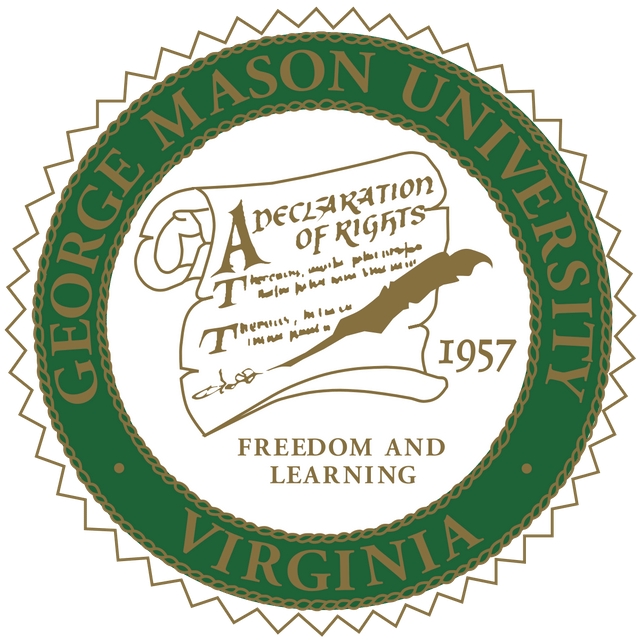
George Mason University

| Motto | Freedom and Learning |
|---|---|
| Type | Public university |
| Established | October 1, 1949[13]:5 |
Academic affiliations | APLU ORAU SURA |
| Endowment | US$85.4 million (December 2017)[14] |
| President | Anne Holton (interim)[15] |
| Provost | S. David Wu |
Academic staff | 2,609 total (1,260 full-time; 1,349 part-time)[16] |
Administrative staff | 2,497 total (763 administrative faculty; 1,734 classified staff)[17] |
| Students | 35,047[16] |
| Undergraduates | 24,149 (2017–2018)[16] |
| Postgraduates | 10,358 (2017–2018)[16] |
| Location | Arlington, VA, US; Fairfax, VA, US; Front Royal, VA, US; Prince William, VA, US; Songdo, South Korea [20] |
| Campus | Suburban, 1,148 acres (4.65 km2) total across 4 campuses 953 acres (3.86 km2) Fairfax Campus |
| Colors | Green and Gold[21] |
| Nickname | Patriots |
Sporting affiliations | NCAA Division I – A-10 |
| Mascot | The Patriot |
| Website | gmu.edu [209] |
 | |
| University rankings | |
| National | |
| Forbes[93] | 177 |
| Times/WSJ[94] | 231 |
| U.S. News & World Report[95] | 136 |
| Washington Monthly[96] | 51 |
| Global | |
| ARWU[97] | 201–300 |
| QS[98] | 801–1000 |
| Times[99] | 301–350 |
| U.S. News & World Report[100] | 827 |
George Mason University (GMU, Mason, or George Mason) is a public research university in Fairfax, Virginia.[22] It was officially established in 1956 as a Northern Virginia branch of the University of Virginia[23] and later became an independent institution in 1972.[13] It has since grown to become the largest four-year public university in the Commonwealth of Virginia. The university is named after the founding father George Mason, a Virginia planter and politician who authored the Virginia Declaration of Rights, the basis for the U.S. Constitution's Bill of Rights. Mason operates four campuses in Virginia, with a fifth campus in Songdo, South Korea.
The university is classified among "R1: Doctoral Universities – Very high research activity".[24] The university is particularly well known in the fields of economics and law and economics. Two Mason economics professors have won the Nobel Memorial Prize in Economics: James M. Buchanan in 1986 and Vernon L. Smith in 2002.[25]
EagleBank Arena (formerly the Patriot Center), a 10,000-seat arena and concert venue operated by the university, is located on the main Fairfax campus. The university recognizes 500 student groups as well as 41 fraternities and sororities.
| Motto | Freedom and Learning |
|---|---|
| Type | Public university |
| Established | October 1, 1949[13]:5 |
Academic affiliations | APLU ORAU SURA |
| Endowment | US$85.4 million (December 2017)[14] |
| President | Anne Holton (interim)[15] |
| Provost | S. David Wu |
Academic staff | 2,609 total (1,260 full-time; 1,349 part-time)[16] |
Administrative staff | 2,497 total (763 administrative faculty; 1,734 classified staff)[17] |
| Students | 35,047[16] |
| Undergraduates | 24,149 (2017–2018)[16] |
| Postgraduates | 10,358 (2017–2018)[16] |
| Location | Arlington, VA, US; Fairfax, VA, US; Front Royal, VA, US; Prince William, VA, US; Songdo, South Korea [20] |
| Campus | Suburban, 1,148 acres (4.65 km2) total across 4 campuses 953 acres (3.86 km2) Fairfax Campus |
| Colors | Green and Gold[21] |
| Nickname | Patriots |
Sporting affiliations | NCAA Division I – A-10 |
| Mascot | The Patriot |
| Website | gmu.edu [209] |
 | |
| University rankings | |
| National | |
| Forbes[93] | 177 |
| Times/WSJ[94] | 231 |
| U.S. News & World Report[95] | 136 |
| Washington Monthly[96] | 51 |
| Global | |
| ARWU[97] | 201–300 |
| QS[98] | 801–1000 |
| Times[99] | 301–350 |
| U.S. News & World Report[100] | 827 |
History
Timeline from center to college then university
| Year | Institution Name | Institution Location | Institution Executive |
|---|---|---|---|
| 1949 | Northern Virginia University Center of the University of Virginia[26] | Arlington | Director John Norville Gibson Finley[13] |
| 1956 | University College of the University of Virginia[27] | Bailey's Crossroads | Director John Norville Gibson Finley[13] |
| 1959 | George Mason College of the University of Virginia[28][29] | Bailey's Crossroads | Director John Norville Gibson Finley[13] |
| 1964 | George Mason College of the University of Virginia[30] | Bailey's Crossroads (Jan. 1964 to June 1964), later Fairfax (beginning Sept. 1964) | Director Robert Reid[31] |
| 1966 | George Mason College of the University of Virginia | Fairfax | Chancellor Lorin A. Thompson[32] |
| 1972 | George Mason College of the University of Virginia | Fairfax | President Lorin A. Thompson[33] |
| 1973 | George Mason College of the University of Virginia | Fairfax | President Vergil H. Dykstra[33] |
| 1977 | George Mason University | Fairfax | President Robert C. Krug[34] |
| 1979 | George Mason University | Fairfax | President George W. Johnson[35] |
| 1979 | George Mason University | Fairfax, Arlington | President George W. Johnson[35] |
| 1996 | George Mason University | Fairfax, Arlington | President Alan G. Merten[36] |
| 1997 | George Mason University | Fairfax, Arlington, Prince William | President Alan G. Merten[36] |
| 2005 | George Mason University | Fairfax, Arlington, Prince William, Ras al Khayma[37] | President Alan G. Merten[36] |
| 2009 | George Mason University | Fairfax, Arlington, Prince William | President Alan G. Merten[37] |
| 2011 | George Mason University | Fairfax, Arlington, Prince William, Front Royal | President Alan G. Merten[36] |
| 2012 | George Mason University | Fairfax, Arlington, Prince William, Front Royal | President Ángel Cabrera[38] |
| 2012 | George Mason University | Fairfax, Arlington, Prince William, Front Royal, Songdo | President Ángel Cabrera[38] |
University of Virginia (1949–1972)
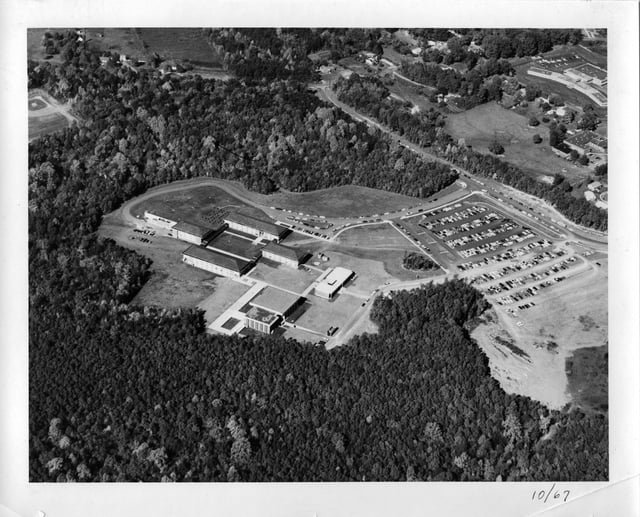
Aerial photograph taken in 1967 showing what was then called George Mason College
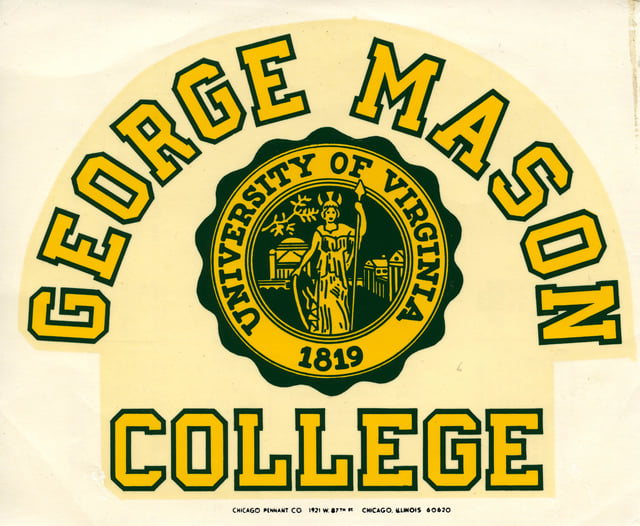
Decal from when George Mason College was a part of the University of Virginia
The University of Virginia in Charlottesville created an extension center to serve Northern Virginia.[39] "… the University Center opened, on October 1, 1949..."[13] The extension center offered both for credit and non-credit informal classes in the evenings in the Vocational Building of the Washington-Lee High School in Arlington, Virginia, at schools in Alexandria, Fairfax, and Prince William, at federal buildings, at churches, at the Virginia Theological Seminary, and at Marine Corps Base Quantico, and even in a few private homes.[13] [] The first for credit classes offered were: "Government in the Far East, Introduction to International Politics, English Composition, Principles of Economics, Mathematical Analysis, Introduction to Mathematical Statistics, and Principles of Lip Reading."[13] By the end of 1952, enrollment increased to 1,192 students from 665 students the previous year.[13]
A resolution of the Virginia General Assembly in January 1956 changed the extension center into University College, the Northern Virginia branch of the University of Virginia.[40] John Norville Gibson Finley served as director.[41] Seventeen freshmen students attended classes at University College in a small renovated elementary school building in Bailey's Crossroads starting in September 1957.[42] In 1958 University College became George Mason College.[40]
The City of Fairfax purchased and donated 150 acres (0.61 km2) of land just south of the city limits to the University of Virginia for the college's new site, which is now referred to as the Fairfax Campus. In 1959, the Board of Visitors of the University of Virginia selected a permanent name for the college: George Mason College of the University of Virginia. The Fairfax campus construction planning that began in early 1960 showed visible results when the development of the first 40 acres (160,000 m2) of Fairfax Campus began in 1962. In the Fall of 1964 the new campus welcomed 356 students.[43]
During the 1966 Session of the Virginia General Assembly, Alexandria delegate James M. Thomson, with the backing of the University of Virginia, introduced a bill in the General Assembly to make George Mason College a four-year institution under the University of Virginia's direction. The measure, known as H 33,[44] passed the Assembly easily and was approved on March 1, 1966 making George Mason College a degree-granting institution. During that same year, the local jurisdictions of Fairfax County, Arlington County, and the cities of Alexandria and Falls Church agreed to appropriate $3 million to purchase land adjacent to Mason to provide for a 600-acre (2.4 km2) Fairfax Campus with the intention that the institution would expand into a regional university of major proportions, including the granting of graduate degrees.
George Mason University (1972–present)
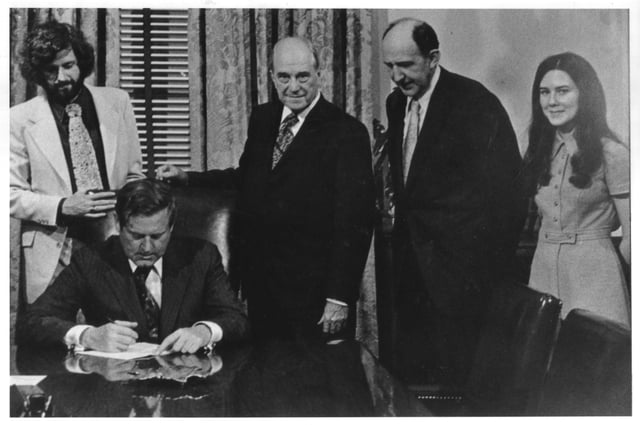
Governor A. Linwood Holton signs H‑210 separating George Mason College from the University of Virginia, April 7, 1972
On Friday, April 7, 1972, a contingent from George Mason College, led by Chancellor Lorin A. Thompson, met with Virginia Governor A. Linwood Holton at Richmond. They were there to participate in the governor's signing into law Virginia General Assembly Bill H 210 separating George Mason College from the University of Virginia at Charlottesville and renaming it George Mason University.[45] In 1978, George W. Johnson was appointed to serve as the fourth president.[46] Under his eighteen-year tenure, the university expanded both its physical size and program offerings at a tremendous rate.[46][47] Shortly before Johnson's inauguration in April 1979, Mason acquired the School of Law and the new Arlington Campus. The university also became a doctoral institution.[46] Toward the end of Johnson's term, Mason would be deep in planning for a third campus in Prince William County at Manassas. Major campus facilities, such as Student Union Building II, EagleBank Arena, Center for the Arts, and the Johnson Learning Center, were all constructed over the course of Johnson's eighteen years as University President. Enrollment once again more than doubled from 10,767 during the fall of 1978 to 24,368 in the spring of 1996.[48]
Dr. Alan G. Merten was appointed president in 1996. He believed that the university's location made it responsible for both contributing to and drawing from its surrounding communities—local, national, and global. George Mason was becoming recognized and acclaimed in all of these spheres. During Merten's tenure, the university hosted the World Congress of Information Technology in 1998,[49] celebrated a second Nobel Memorial Prize-winning faculty member in 2002, and cheered the Men's Basketball team in their NCAA Final Four appearance in 2006. Enrollment increased from just over 24,000 students in 1996 to approximately 33,000 during the spring semester of 2012, making Mason Virginia's largest public university and gained prominence at the national level.[50]
Dr. Ángel Cabrera officially took office on July 1, 2012. Both Cabrera and the board were well aware that Mason was part of a rapidly changing academia, full of challenges to the viability of higher education. In a resolution on August 17, 2012, the board asked Dr. Cabrera to create a new strategic vision that would help Mason remain relevant and competitive in the future. The drafting of the Vision for Mason, from conception to official outline, created a new mission statement that defines the university.[51]
On March 25, 2013, university president Ángel Cabrera held a press conference to formally announce the university's decision to leave the Colonial Athletic Association to join the Atlantic 10 Conference (A-10). The announcement came just days after the Board of Visitors' approval of the university's Vision document that Dr. Cabrera had overseen. Mason began competition in the A-10 during the 2013–2014 academic year, and Mason's association with the institutions that comprise the A-10 started a new chapter in Mason athletics, academics, and other aspects of university life.[52] The Chronicle of Higher Education listed Mason as one of the "Great Colleges to Work For" from 2010–2014.[53] The Washington Post listed Mason as one of the "Top Workplaces" in 2014.[54] The WorldatWork Alliance for Work-Life Progress awarded Mason the Seal of Distinction in 2015.[55] The AARP listed Mason as one of the Best Employers for Workers Over 50 in 2013.[56] Phi Beta Kappa established a chapter at the university in 2013.
In 2018, a Freedom of Information Act lawsuit revealed that conservative donors, including the Charles Koch Foundation and Federalist Society, were given direct influence over faculty hiring decisions at the university's law and economics schools. GMU President Ángel Cabrera acknowledged that the revelations raised questions about the university's academic integrity and pledged to prohibit donors from sitting on faculty selection committees in the future.[57]
Campuses
George Mason University has four campuses in the United States, all within the Commonwealth of Virginia.[58] Three are within the Northern Virginia section of the Piedmont, and one in the Blue Ridge Mountains region.[58] The university has one campus in South Korea, within the Incheon Free Economic Zone of the Songdo region.[59][58] The university had a campus at Ras al-Khaimah, but that location is now closed.[37] The Blue Ridge campus, just outside Front Royal, is run in cooperation with the Smithsonian Institution.[60]
Fairfax
| Fairfax Campus |
|---|
 Johnson Center and Center for the Arts[1] |
The university's Fairfax Campus is situated on 677 acres (1.058 sq mi) of landscaped land with a large pond in a suburban environment in George Mason, Virginia, just south of the City of Fairfax in central Fairfax County. Off-campus amenities are within walking distance and Washington, D.C. is approximately 20 miles (32 km) from campus.[2] Notable buildings include the 320,000-square-foot (30,000 m2) student union building, the Johnson Center; the Center for the Arts, a 2,000-seat concert hall; the 180,000-square-foot (17,000 m2) Long and Kimmy Nguyen Engineering Building; Exploratory Hall for science, new in 2013; an astronomy observatory and telescope; the 88,900-square-foot (8,260 m2) Art and Design Building; the newly expanded Fenwick Library, and will soon reconstruct the academic buildings Robinson A and B;[63] the Krasnow Institute; and three fully appointed gyms and an aquatic center for student use.[64] The stadiums for indoor and outdoor track and field, baseball, softball, tennis, soccer and lacrosse are also on the Fairfax campus,[65] as is Masonvale, a housing community for faculty, staff and graduate students.[66] The smallest building on the campus is the 33-square-foot (3.1 m2) information booth.[67]
Transportation
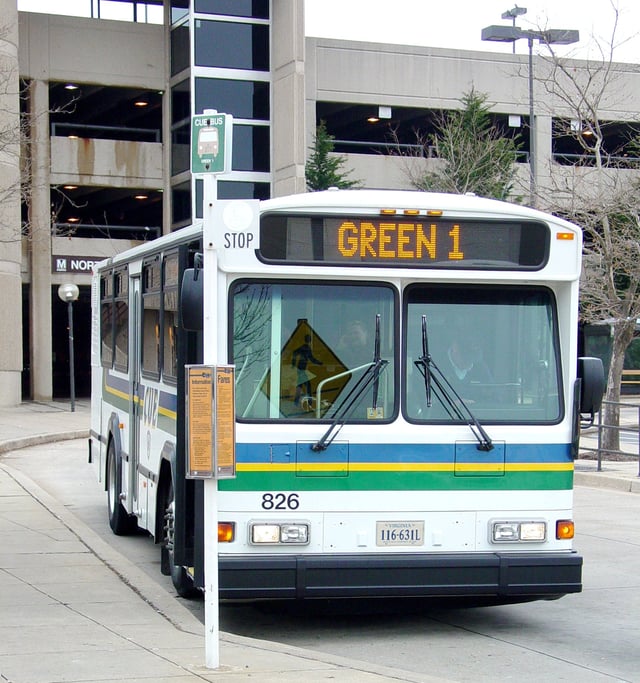
Fairfax City CUE Bus at Vienna, Fairfax, GMU station[3]
This campus is served by the Washington Metro Orange Line at the Vienna, Fairfax, GMU station as well as Metrobus routes.[68] The CUE Bus Green One, Green Two, Gold One, and Gold Two lines all provide service to this campus at 38°50′05″N 77°18′25″W [210] .[69] This campus is served by the Virginia Railway Express Manassas Line at the Burke Center station.[70] Fairfax Connector Route 306: GMU–Pentagon provides service to this campus.[71] Mason provides shuttle service between this campus and Vienna, Fairfax, GMU Metro station, the Burke Center VRE station, the Science and Technology Campus, West Campus, and downtown City of Fairfax.[72]
George Mason statue

Location of statue
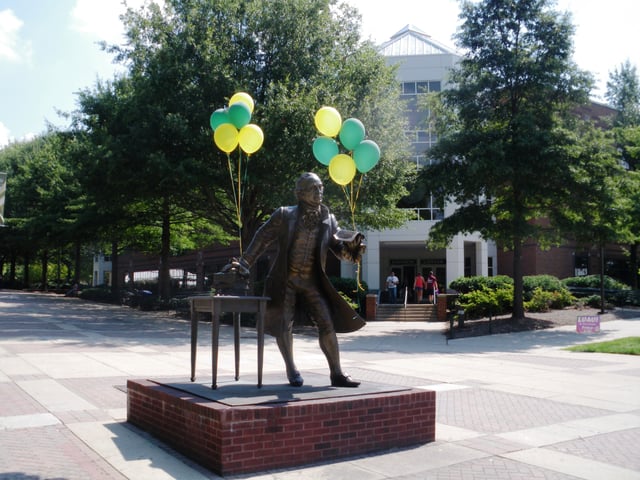
Statue of George Mason on the Fairfax campus,[4] adorned with balloons
The bronze statue of George Mason on campus[5] was created by Wendy M. Ross and dedicated on April 12, 1996.[73] The 71/2 foot statue shows George Mason presenting his first draft of the Virginia Declaration of Rights which was later the basis for the U.S. Constitution's Bill of Rights. Beside Mason is a model of a writing table that is still in the study of Gunston Hall, Mason's Virginia estate. The books on the table—volumes of Hume, Locke and Rousseau—represent influences in his thought.
Arlington
The Arlington Campus is situated on 5.2 acres (21,000 m2; 0.0081 sq mi) in a bustling urban environment on the edge of Arlington, Virginia's Clarendon business district and four miles (6.4 km) from downtown Washington, D.C. The campus was founded in 1979 with the acquisition of a law school;[74] in 1998 Hazel Hall opened to house the Mason School of Law; subsequent development created Founders Hall, home of the Schar School of Policy and Government,[75] the Center for Regional Analysis,[76] and the graduate-level administrative offices for the School of Business.[77] Vernon Smith Hall houses the School for Conflict Analysis and Resolution, the Mercatus Center, and the Institute for Humane Studies. The campus also houses the 300-seat Founders Hall Auditorium.
Transportation
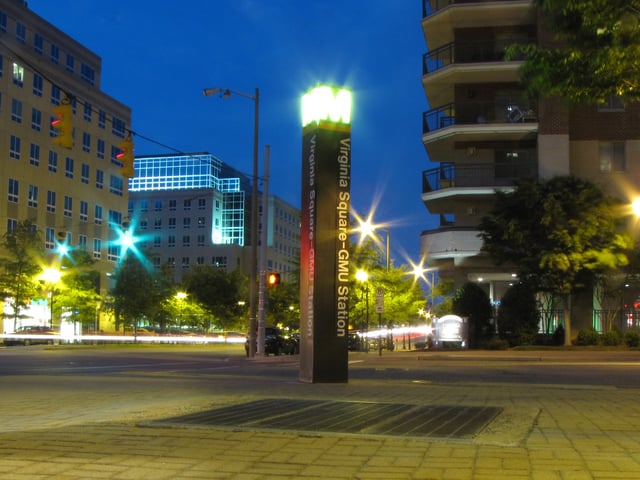
Arlington campus subway stop
This campus is served by the Washington Metro Orange Line at the Virginia Square-GMU station as well as Metrobus route 38B.[8] The rail station is located one block west of the campus.[79] Arlington Rapid Transit or ART Bus routes 41, 42, and 75 also provide service at this location.[78] The campus offers one electric vehicle charging station, five disabled permit automotive parking locations, three bicycle parking locations, and one Capitol Bikeshare location.[79]
Science and Technology
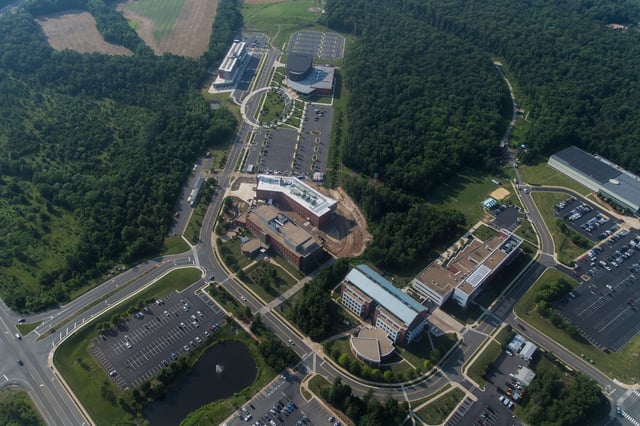
Beacon Hall, Hylton Performing Arts Center, the EDGE, Life Sciences Laboratory, Discovery Hall, Occoquan Building, Freedom Aquatic and Fitness Center, Bull Run Hall, Biomedical Research Laboratory[9]
The Science and Technology campus opened on August 25, 1997 as the Prince William campus in Manassas, Virginia, on 134 acres (0.209 sq mi; 540,000 m2) of land, some still currently undeveloped.[80] More than 4,000 students are enrolled in classes in bioinformatics, biotechnology, information technology, and forensic biosciences educational and research programs.[81] There are undergraduate programs in health, fitness and recreation. There are graduate programs in exercise, fitness, health, geographic information systems, and facility management. Much of the research takes place in the high-security Biomedical Research Laboratory.[82] The 1,123-seat Merchant Hall and the 300-seat Verizon Auditorium in the Hylton Performing Arts Center opened in 2010.[83][84]
The 110,000-square-foot Freedom Aquatic and Fitness Center is operated by the Mason Enterprise Center.[85] The Mason Center for Team and Organizational Learning stylized as EDGE is an experiential education facility open to the public.[86] The Sports Medicine Assessment Research and Testing lab stylized as SMART Lab is located within the Freedom center. The SMART Lab is most known for its concussion research.[87] On April 23, 2015 the campus was renamed to the Science and Technology Campus.[88]
Smithsonian-Mason School of Conservation
The campus in Front Royal, Virginia is a collaboration between the Smithsonian Institution and the university.[60] Open to students in August 2012 after breaking ground on the project on June 29, 2011, the primary focus of the campus is global conservation training.[60] The Volgenau Academic Center includes three teaching laboratories, four classrooms, and 18 offices.[60] Shenandoah National Park is visible from the dining facility's indoor and outdoor seating.[60] Living quarters include 60 double occupancy rooms, an exercise facility, and study space.[60]
Songdo, South Korea
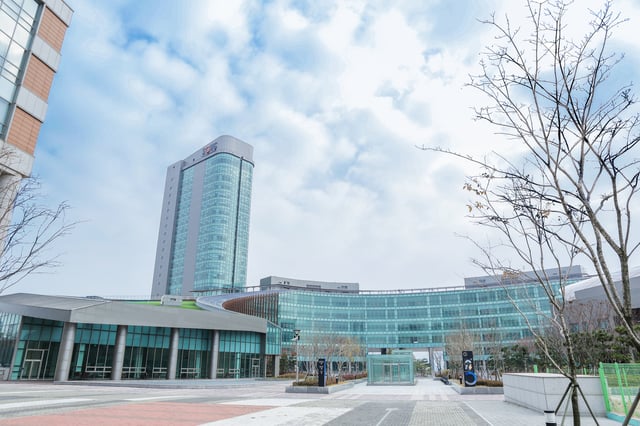
Data Center, Library, Guest House, Student's Hall[12]
Opened in March 2014, the Songdo campus is in South Korea's Incheon Free Economic Zone, a 42,000-acre (66 sq mi) site designed for 850,000 people. It's 25 miles (40 km) from Seoul and a two-hour flight from China and Japan.
The Commonwealth of Virginia considers the Songdo campus legally no different than any other Mason campus, "... board of visitors shall have the same powers with respect to operation and governance of its branch campus in Korea as are vested in the board by the Code of Virginia with respect to George Mason University in Virginia ..."[89]
Mason Korea students will spend the sixth and seventh semesters (one year) on the Fairfax Campus, with all other course work to be completed in Songdo. George Mason University Korea offers seven undergraduate programs: Management, Finance, Accounting, Economics, Global Affairs, Conflict Analysis and Resolution, and Computer Game Design. Mason Korea also has two graduate programs: Systems Engineering and IB & ESOL.
Mason Korea's first commencement class graduated in December 2017.[90] Students from Mason Korea earn the same diploma as home campus students.
Academics and rankings
Colleges and schools
| Colleges and Schools of George Mason University | ||||||||||||
|---|---|---|---|---|---|---|---|---|---|---|---|---|
| Historical name | Current name | |||||||||||
| College of Arts and Sciences 1957 | College of Humanities and Social Sciences 2006[101] | |||||||||||
| College of Science 2006[102] | ||||||||||||
| School of Business Administration 1977 | School of Business 2014[77] | |||||||||||
| School of Law 1979 | Antonin Scalia Law School 2016[103] | |||||||||||
| School of Information Technology and Engineering 1985 | Volgenau School of Engineering 2005[104] | |||||||||||
| School of Nursing 1985 | College of Health and Human Services 1998[105] | |||||||||||
| College of Visual and Performing Arts 1990[106] | ||||||||||||
| School of Public Policy 1990 | Schar School of Policy and Government 2016[107] | |||||||||||
| Department of Public and International Affairs 1990 | ||||||||||||
| Graduate School of Education 1991 | College of Education and Human Development 1994[108] | |||||||||||
| School for Conflict Analysis and Resolution 1991 | ||||||||||||
| Krasnow Institute for Advanced Study 1993 | ||||||||||||
Admissions
Between 2009 and 2013, George Mason saw a 21% increase in the number of applications, has enrolled 4% more new degree-seeking students, and has seen the percentage of undergraduate and graduate applications accepted each decrease by 4%. Law applications accepted increased by 10%.[91] Mason enrolled 33,917 students for Fall 2013, up 956 (+3%) from Fall 2012. Undergraduate students made up 65% (21,990) of the fall enrollment, graduate students 34% (11,399), and law students 2% (528). Undergraduate headcount was 1,337 higher than Fall 2012 (+7%); graduate headcount was 262 lower (−2%); and law student headcount was 119 lower (−18%). Matriculated students come from all 50 states and 122 foreign countries.[91] As of fall 2014, the university had 33,791 students enrolled, including 21,672 undergraduates, 7,022 seeking master's degrees, 2,264 seeking doctoral degrees and 493 seeking law degrees.[91]
Enrollment
Accreditation
George Mason University is accredited by the Commission on Colleges of the Southern Association of Colleges and Schools (SACSCOC) to award bachelor's, master's, and doctoral degrees.[111]
Research
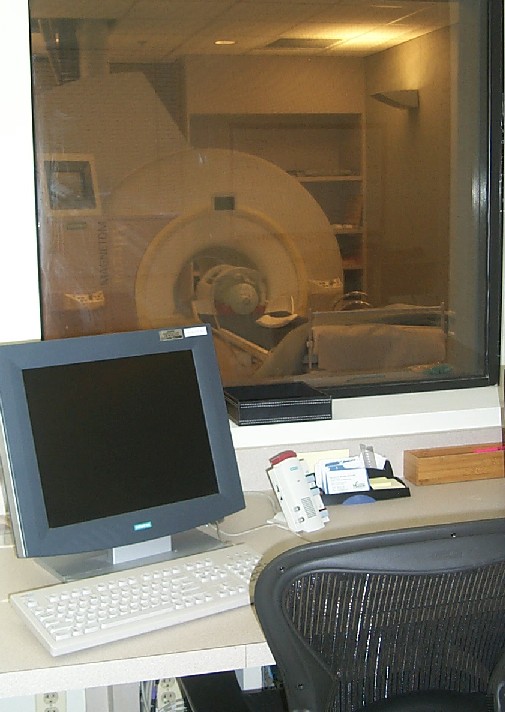
MRI machine used at the Krasnow Institute for Advanced Study[112]
George Mason University, an institution dedicated to research of consequence, hosts more than $100 million in sponsored research projects annually.[113] In 2016, Mason was classified by the Carnegie Classification of Institutions of Higher Education among the U.S. universities that receive the most research funding and award research/scholarship doctorates.[114] Mason moved into this classification based on a review of its 2013–2014 data that was performed by the Center for Postsecondary Research at Indiana University.[115]
The research is focused on health, sustainability and security. In health, researchers focus is on wellness, disease prevention, advanced diagnostics and biomedical analytics. Sustainability research examines climate change, natural disaster forecasting, and risk assessment. Mason's security experts study domestic and international security as well as cyber security.[116]
Centers and institutes
The university is home to numerous research centers and institutes.[117]
Center for Applied Proteomics and Molecular Medicine[118]
Center for Clean Water and Sustainable Technologies (CCWST)[118]
Center for Climate Change Communication (4C)[117]
Center for Collision Safety and Analysis[119]
Center for Excellence in Command, Control, Communications, Computing and Intelligence (C4I)[120]
Center for History and New Media (CHNM)[121]
Center for Location Science[122]
Center for Neural Informatics[123]
Center for Real Estate Entrepreneurship[117]
Center for Regional Analysis[117]
Center for Social Complexity[124]
Center for Study of Public Choice[125]
Center for Neural Informatics, Structures, and Plasticity (CN3)[123]
Center for Well-Being[126]
Institute for Advanced Biomedical Research[127]
Interdisciplinary Center for Economic Science[128]
Krasnow Institute for Advanced Study[118]
Mercatus Center[129]
National Center for Biodefense and Infectious Diseases[118]
SMART Lab (Sports Medicine Assessment, Research & Testing)[130]
Stephen S. Fuller Institute [131]
Partners
Mason has established far-reaching research partnerships with many government agencies, non-profits, health systems, and international finance organizations. Among others, Mason researches computer systems and networks with the Defense Advanced Research Agency (DARPA);[132] investigates climate issues with the National Aeronautics and Space administration (NASA);[133] explores underwater archaeology with the National Oceanic and Atmospheric Administration (NOAA);[134] partners on conservation and biological matters with the Smithsonian institution; studies brain neurons with The Allen Institute;[135] conducts economic research with the International Monetary Fund; and examines chronic illnesses and disabilities with the Inova Health System.
Student life
Traditions
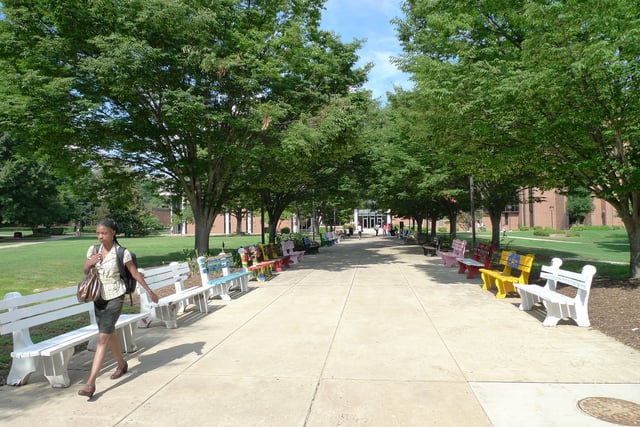
Benches painted by students outside the Fenwick Library

Location of annually painted benches
Students will decorate the George Mason statue on the Fairfax campus for events, some rub the statue toe to bring good luck, and many pose with the statue for graduation photographs.[136] Between 1988 and 1990 Anthony Maiello wrote the original George Mason Fight Song, which was edited by Michael Nickens in 2009.[137]
Each spring, student organizations at Mason compete to paint one of the 38 benches located on the Quad in front of Fenwick Library. For years, student organizations have painted those benches that line the walkway to gain recognition for their group. With more than 300 student organizations, there is much competition to paint one of the benches. Painting takes place in the spring.[138]
Every year since 1965, George Mason University hosts an annual celebration called Mason Day. Mason Day brings food trucks, carnival rides, local artists, and notable performers to campus for the students to de-stress before finals. The event is typically free for students and $20 for the general public.
Housing
| Fairfax Housing |
|---|
 Masonvale Presidents Park Dominion Eastern Shore Hampton Roads Liberty Square Chesapeake Lane [139] Potomac Heights Rogers Student Apartments Townhouses Whitetop Global Center Commons Fairfax Housing |
On the Fairfax campus the northernmost housing is technically on campus, but about a mile from the center of campus, about a half mile from the edge of the majority of the Fairfax campus in the housing area known as the Townhouses.[140] On the Western edge of the Fairfax campus lies Masonvale, houses intended for graduate students and visiting faculty.[141] On the southern edge of the Fairfax campus you will find President's Park, Liberty Square, and Potomac Heights. The easternmost housing on the Fairfax campus, that follow along Ox Road, are the Global Center[142], Student Apartments, Whitetop, and Rogers.[143] Closer to the center of the Fairfax campus are the housing buildings along Chesapeake Lane, named: Northern Neck, Commonwealth, Blue Ridge, Sandbridge, Piedmont, and Tidewater, as well as Hampton Roads, Dominion, Eastern Shore, and the Commons. 21 miles (34 km) west of Fairfax, Beacon Hall is on the Science and Technology campus and was designed for graduate student housing. 54 miles (87 km) west of Fairfax, the G.T. Halpin Family Living & Learning Community is on the Smithsonian-Mason School of Conservation campus. 6,961 miles (11,203 km) west of Fairfax, Student's Hall and Guest House are on the Songdo campus.[89][144]
Dining Options
On-campus robot food delivery
George Mason University's Fairfax Campus is the first U.S. campus to include robot food delivery in its meal plans.[145] 25 autonomous robots were provided by the Estonian robotics company Starship Technologies to carry out meal deliveries.[146] The cost of a delivery, as of January 2019, is $1.99.[145]
Student organizations
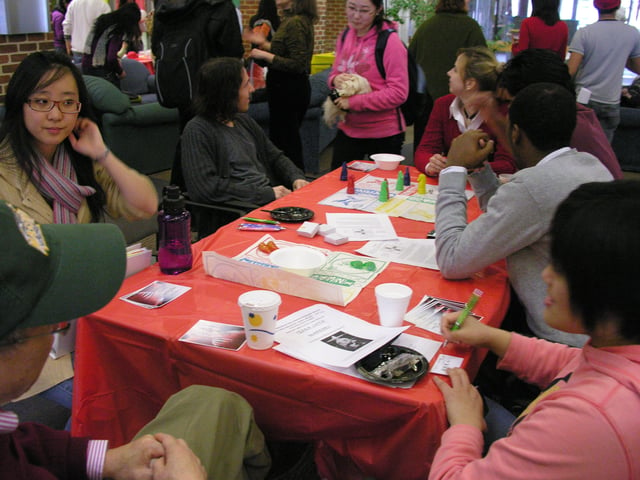
Students participate in Lantern Day
Student organizations can have an academic, social, athletic, religious/irreligious, career, or just about any other focus. The university recognizes 500 such groups.[147]
Student Media
Mason sponsors several student-run media outlets through the Office of Student Media.[148]
The Fourth Estate: Website and weekly student newspaper, available on Mondays[149]
The George Mason Review:**A cross-disciplinary, undergraduate journal.[150]
Hispanic Culture Review: Publishes creative writing, book reviews, narratives, and essays in both Spanish and English. Published annually.[151]
Mason Cable Network: A television outlet run by the students, for the students, that provides analytical, and entertaining programming.[152]
Phoebe: A journal that annually publishes original works of literature and art.[153]
*So to Speak:*A feminist journal that publishes poetry, fiction, nonfiction, and visual art each semester.[154]
Volition: Formerly known as Apathy, is George Mason University's undergraduate creative literature and art magazine.[155]
WGMU Radio: Broadcasts a wide array of music, talk, sports, and news programming. WGMU is also the flagship station for George Mason's Men's and Women's Basketball team, part of the Go Mason Digital Network.[156]
Greek Life Student Organizations
Mason has 41 fraternities and sororities,[157] with a total Greek population of about 1,800. Mason does not have a traditional "Greek Row" of housing specifically for fraternities, although recruitment, charitable events—including a spring Greek Week—and other chapter activities take place on the Fairfax Campus.[158]
| Organization | Letters | Type | Council Affiliation |
|---|---|---|---|
| Alpha Epsilon Pi | ΑΕΠ | fraternity | Interfraternity Council |
| Alpha Kappa Alpha | ΑΚΑ | sorority | National Pan-Hellenic Council |
| alpha Kappa Delta Phi | αΚΔΦ | sorority | Multicultural Greek Council |
| Alpha Kappa Lambda | ΑΚΛ | fraternity | Interfraternity Council |
| Alpha Omicron Pi | ΑΟΠ | sorority | Panhellenic Council |
| Alpha Phi | ΑΦ | sorority | Panhellenic Council |
| Alpha Phi Alpha | ΑΦΑ | fraternity | National Pan-Hellenic Council |
| Alpha Phi Omega | ΑΦΩ | fraternity | Unaffiliated |
| Alpha Sigma Phi | ΑΣΦ | fraternity | Interfraternity Council |
| Alpha Xi Delta | ΑΞΔ | sorority | Panhellenic Council |
| Beta Theta Pi | ΒΘΠ | fraternity | Interfraternity Council |
| Chi Omega | ΧΩ | sorority | Panhellenic Council |
| Chi Psi | ΧΨ | fraternity | Interfraternity Council |
| Chi Upsilon Sigma | ΧΥΣ | sorority | Multicultural Greek Council |
| Delta Chi | ΔΧ | fraternity | Interfraternity Council |
| Delta Phi Omega | ΔΦΩ | sorority | Multicultural Greek Council |
| Delta Sigma Theta | ΔΣΘ | sorority | National Pan-Hellenic Council |
| Delta Sigma Pi | ΔΣΠ | fraternity | |
| Gamma Phi Beta | ΓΦΒ | sorority | Panhellenic Council |
| Iota Phi Theta | ΙΦΘ | fraternity | National Pan-Hellenic Council |
| Kappa Alpha Order | ΚΑ | fraternity | Interfraternity Council |
| Kappa Alpha Psi | ΚΑΨ | fraternity | National Pan-Hellenic Council |
| Kappa Delta | ΚΔ | sorority | Panhellenic Council |
| Kappa Phi Gamma | ΚΦΓ | sorority | Multicultural Greek Council |
| Kappa Phi Lambda | ΚΦΛ | sorority | Multicultural Greek Council |
| Kappa Sigma | ΚΣ | fraternity | Interfraternity Council |
| Lambda Pi Chi | ΛΠΧ | sorority | Multicultural Greek Council |
| Lambda Theta Alpha | ΛΘΑ | sorority | Multicultural Greek Council |
| Omega Psi Phi | ΩΨΦ | fraternity | National Pan-Hellenic Council |
| Phi Beta Sigma | ΦΒΣ | fraternity | National Pan-Hellenic Council |
| Phi Gamma Delta | ΦΓΔ | fraternity | Interfraternity Council |
| Phi Kappa Sigma | ΦΚΣ | fraternity | Interfraternity Council |
| Phi Kappa Theta | ΦΚΘ | fraternity | Interfraternity Council |
| Phi Sigma Kappa | ΦΣΚ | fraternity | Interfraternity Council |
| Pi Beta Phi | ΠΒΦ | sorority | Panhellenic Council |
| Pi Delta Psi | ΠΔΨ | fraternity | Multicultural Greek Council |
| Pi Kappa Alpha | ΠΚΑ | fraternity | Interfraternity Council |
| Pi Kappa Phi | ΠΚΦ | fraternity | Interfraternity Council |
| Sigma Alpha Epsilon | ΣΑΕ | fraternity | Interfraternity Council |
| Sigma Chi | ΣΧ | fraternity | Interfraternity Council |
| Sigma Gamma Rho | ΣΓΡ | sorority | National Pan-Hellenic Council |
| Sigma Psi Zeta | ΣΨΖ | sorority | Multicultural Greek Council |
| Tau Kappa Epsilon | TKE | fraternity | Interfraternity Council |
| Theta Chi | ΘΧ | fraternity | Interfraternity Council |
| Zeta Phi Beta | ΖΦΒ | sorority | National Pan-Hellenic Council |
| Zeta Tau Alpha | ΖΤΑ | sorority | Panhellenic Council |
Religious or spiritual student organizations
George Mason University is a public government-funded university that has to comply with the First Amendment of the United States Constitution.[159] The university as being part of the government of the Commonwealth of Virginia, cannot endorses or establish a religion nor can it impeded the "free exercise of religion" of its students. Therefore, independent religious student-led organizations can register with the university in order to minister to the students at their own choosing. The registered student religious organizations are as follows[160]:
| Student Organization | Abbr. | Religion | Denomination or Sect | National Affiliation | Type |
|---|---|---|---|---|---|
| 4Corners Christian Fellowship | 4Corners | Christianity | Fellowship | ||
| Access Islam | Islam | Academic/Theological | |||
| Ahmadiyya Muslim Student Association | Islam | Ahmadiyya Movement | Appreciation & Philosophy | ||
| Align Fitness[161] | Sports Ministry Fellowship | ||||
| Anointed Vessels of Unity | AVU | Christianity | |||
| Apostles Campus Church | ACC | Christianity | Anglican | Church | |
| Arise Campus Ministry | Christianity | Christian Church (Disciples of Christ), Episcopal (Anglican), Presbyterian (USA), United Church of Christ, United Methodist (Wesleyan) | Wesley Foundation, Canterbury Club, Presbyterian House | ||
| Baha'i Club | Bahá'í Faith | Bahá’í Campus Ministry | |||
| Bridges International | Christianity | Bridges International | Community Organization | ||
| George Mason Catholic Campus Ministry (St. Robert Bellarmine Chapel) | CCM | Christianity | Catholic | Works with the Fellowship of Catholic University Students (FOCUS) | Catholic campus ministry | Fellowship & Church |
| Chi Alpha(Chi Alpha Christian Fellowship) | ΧΑ | Christianity | interdenominationalnon-denominational (local chapter) | Chi Alpha Campus Ministries(Assemblies of God USA -- national affiliate) | Fellowship |
| GMU Christians on Campus | Christianity | Christians on Campus | Fellowship | ||
| Coptic Orthodox Christian Association | Christianity | Coptic Orthodox Christian Church | Coptic Orthodox Christian Association | Association | |
| Cru (MasonCru) | Cru | Christianity | interdenominational | Cru (Christian organization) | Fellowship |
| Delight Ministries | Christianity | Delight Ministries | A College Women's Community Ministry | ||
| Disciples on Campus | Christianity | Disciples on Campus | Fellowship | ||
| EPIC Movement (Asian American Fellowship) | EPIC | Christianity | Cultural, Fellowship | ||
| Every Nation Campus - GMU | ENC | Christianity | Evangelicalism | Every Nation Churches & Ministries | Campus Ministry & Church |
| Fellowship of Catholic University Students | FOCUS | Christianity | Catholic | Fellowship of Catholic University Students | Fellowship & Church |
| Fellowship of Christian Athletes | FCA | Christianity | interdenominational non-denominational | Fellowship of Christian Athletes | Sports Ministry Fellowship |
| First Love Church | Christianity | Fellowship & Church | |||
| Hillel | Jewish (religion) | Professional Association | |||
| Immanuel Christian Fellowship | ICF | Christianity | non-denominational (Evangelical-leaning) | Immanuel Bible Church (Servants Ministry) | Fellowship |
| Klesis | Κλεσις | Christianity | Baptist | Fellowship | |
| Korean Bible Study of GMU | Christianity | Cultural, Fellowship (conducted in Korean) | |||
| GMU [Make]New | Christianity | MakeNew Christian Fellowship | Fellowship | ||
| Mason InterVarsity | IV | Christianity | interdenominational (Evangelical-leaning) | InterVarsity Christian Fellowship | Fellowship |
| Muslim Leadership Development | Islam | Leadership Development | |||
| Muslim Students' Association | Islam | non-denominational | Halaqas (study circles) | ||
| NxGeneration Campus Ministry | Christianity | Young Adult/Youth Ministry | |||
| Orthodox Christian Fellowship | Christianity | Orthodox Christianity | Fellowship | ||
| Patriot Christian Ministry | Christianity | Fellowship | |||
| Promises United in God | Christianity | Fellowship | |||
| Ratio Christi | Christianity | non-denominational | Ratio Christi | Apologetics | |
| SERVE | Christianity | Community Services | |||
| Secular Student Alliance (GMU)[162] | SSA | Nontheism | human-based ethics | Secular Student Alliance | Special Interest |
| Sikh Student Association | Sikhism | Association | |||
| Student Bible Study | Christianity | Bible Study | |||
| The Gathering | Christianity | Movement | |||
| The Impact Movement at Mason (Black, African, African-American Fellowship) | Christianity | Cultural, Fellowship | |||
| The Latter-Day Saint Student Association | LDSSA | Christianity | Mormonism | The Church of Jesus Christ of Latter-day Saints | Gospel Study (Institute of Religion Class) |
| University Bible Fellowship | UBF | Christianity | mainline evangelical | Fellowship & Church | |
| Young Life | YL | Christianity | Presbyterianism | Young Life | Fellowship |
Athletics
Division I teams
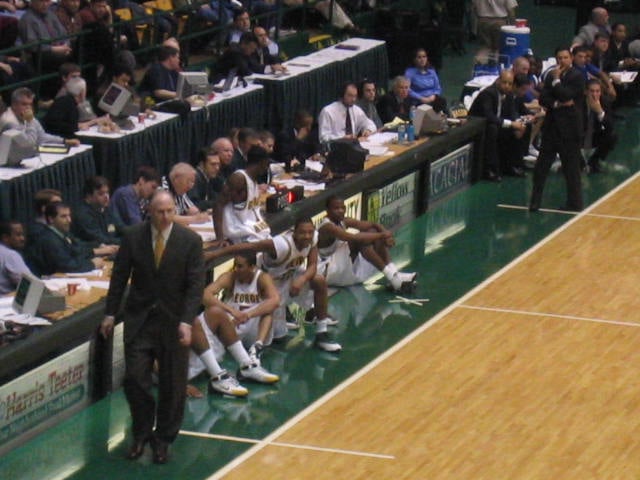
Hofstra visits the Patriot Center[163] on January 26, 2005
The George Mason Patriots are the athletic teams of George Mason University located in Fairfax, Virginia.[164] The Patriots compete in Division I of the National Collegiate Athletic Association as members of the Atlantic 10 Conference for most sports. About 485 student-athletes compete in 22 men's and women's Division I sports – baseball, basketball, cross-country, golf, lacrosse, rowing, soccer, softball, swimming and diving, tennis, indoor and outdoor track and field, volleyball, and wrestling. Intercollegiate men's and women's teams are members of the National Athletic Association (NCAA) Division I, the Atlantic 10, the Eastern College Athletic Conference (ECAC), the Eastern Intercollegiate Volleyball Association (EIVA), the Eastern Wrestling League (EWL), and the Intercollegiate Association of Amateur Athletes of America (IC4A).[165]
Club sports[166]
In addition to its NCAA Division I teams, George Mason University has several club sports.[167] The club sports offer students a chance to compete at a high level without the time commitment of a D-I/Varsity team in sports including – badminton, baseball, basketball (women's), bowling, cricket, crew, cycling, equestrian, fencing, field hockey, football, ice hockey, lacrosse (men's and women's), paintball, powerlifting, quidditch, rugby (men's and women's), running, soccer (men's and women's), swimming, tae kwon do, trap & skeet, triathlon, ultimate frisbee (men's and women's), volleyball (men's and women's), wrestling, and underwater hockey. Clubs have a competitive range from regional competition to yearly participation in U.S. National College Club Level Championships
| Name | Sport |
|---|---|
| Badminton Club | Badminton |
| Club Baseball | Baseball |
| Club Field Hockey | Field Hockey |
| Club Football | Football |
| George Mason Club Softball | Softball |
| George Mason Crew Club | Crew |
| George Mason Fencing Club | Fencing |
| George Mason Men's Club Soccer | Soccer |
| George Mason Squash Club | Squash |
| George Mason University Running Club | Running |
| GMU Brazilian Jiu-Jitsu | Jiu-Jitsu (Brazilian) |
| GMU Club Tennis | Tennis |
| GMU Esports | Esports |
| GMU Men's Lacrosse Club | Lacrosse |
| GMU Men's Rugby Football Club | Rugby Football |
| GMU Trap and Skeet | Trap and Skeet |
| Log Rolling Club | Log Rolling |
| Mason Equestrian Club | Equestrian Sports |
| Mason Powerlifting | Powerlifting |
| Mason Quidditch Club | Quidditch |
| Mason Swim Club | Swimming |
| Mason Taekwondo | Taekwondo |
| Men's Club Ultimate | Ultimate Frisbee |
| Men's Club Volleyball | Volleyball |
| Men's Ice Hockey | Ice Hockey |
| Underwater Hockey | Underwater Hockey |
| Women's Club Basketball | Basketball |
| Women's Club Ice Hockey | Ice Hockey |
| Women's Club Lacrosse | Lacrosse |
| Women's Club Soccer | Soccer |
| Women's Rugby Club | Rugby |
| Women's Ultimate Frisbee | Ultimate Frisbee |
| Women's Volleyball Club | Volleyball |
Performing Arts
Mason Players
The Mason Players is a faculty lead student organization that produces six productions. This season includes two "Main Stage" productions, which are directed by faculty members or guest artists. As well as "Studio" productions, which are directed by students through an application process within Mason Players. There is also an annual production of "Originals", which consists of 10 minute original plays written by students. Full time students of George Mason University, both outside and a part of the School of Theater are allowed to audition for these productions. [168]
Notable faculty and alumni
Faculty
James M. Buchanan, 1986 Nobel Memorial Prize winner for Economics[169]
Bryan Caplan, economist, blogger at EconTalk, author of The Myth of the Rational Voter and The Case Against Education.[170]
Tyler Cowen, economist, director of the Mercatus Center at Mason and founder of the blog Marginal Revolution[171]
Helen C. Frederick, artist and printmaker
Jack Goldstone, sociologist and political scientist specializing in revolutions; nonresident senior fellow at the Brookings Institution; 2014 winner of Guggenheim Award[172]
Hugh Heclo, political scientist, Guggenheim Fellow, and Clarence J. Robinson Professor of Public Affairs
Steven Pearlstein, Pulitzer Prize winner for economics in the Washington Post[173]
Russ Roberts, economist and host of EconTalk[174]
Roy Rosenzweig, Fulbright scholar, historian, founded Center for History and New Media[175]
Martin Sherwin, Pulitzer Prize winner for his biography of Robert Oppenheimer[176]
Vernon L. Smith, 2002 Nobel Memorial Prize-winning economist.[177]
Louise Shelley, 2015 Andrew Carnegie Fellow from the Carnegie Corporation of New York.[178]
Gordon Tullock, co-founder of public choice economics.[179]
Roger Wilkins, Clarence J. Robinson Professor of History and American Culture, Pulitzer Prize winner, journalist, civil rights leader and former Assistant Attorney General of the Unites States
Walter E. Williams, John M. Olin Distinguished Professor of Economics[180]
Brett Kavanaugh, Supreme Court Justice[181]
Alumni
Abdiweli Mohamed Ali, President of Puntland and Prime Minister of Somalia[182]
Anousheh Ansari, Iranian-American engineer, co-founder of Prodea Systems and the first Muslim woman in space[183]
Archie Kao, actor best known for Power Rangers Lost Galaxy, Chicago P.D., and CSI: Crime Scene Investigation[184]
Justin Bour, professional baseball player with the Los Angeles Angels of Aneheim [185]
Anna E. Cabral, Treasurer of the United States under President George W. Bush[186]
Shawn Camp, baseball player, Toronto Blue Jays[187]
Kathleen L. Casey, Commissioner of the U.S. Securities and Exchange Commission[188]
Nikki Hornsby, Grammy Voting Recording Artist, Singer, Songwriter, Musician, Founder of CJP-NHRecords.com, carrying on the Hornsby Family Music Tradition Internationally.
Rhea Seehorn, actress best known for playing Kim Wexler on Better Call Saul.[189]
Erden Eruç, president and CEO of the non-profit Around-n-Over and the first solo human-powered circumnavigation of the globe[190]
Carolyn Kreiter-Foronda, former Poet Laureate of Virginia[191]
David Jolly, former member of the United States House of Representatives[192]
Jake Kalish, baseball player[193]
Dayton Moore, general manager, senior VP of the Kansas City Royals[194]
Denise Turner Roth, Administrator of the U.S. General Services Administration (GSA)[195]
Steve Ricchetti, former Deputy Chief of Staff to President Bill Clinton[196]
Karl Rove, former Deputy Chief of Staff to President George W. Bush[197]
Martin Andrew Taylor, former senior executive Corporate VP of Windows Live and MSN, Chief of Staff to former Microsoft CEO Steve Ballmer[198]
Jim Hagedorn, congressman from Minnesota's first congressional district
Hala Gorani, anchor and senior correspondent for CNN International
See also
George Mason University's historical hoaxes




